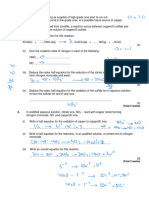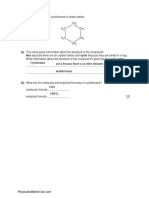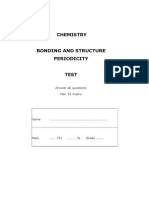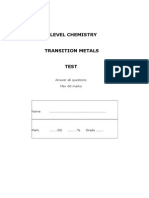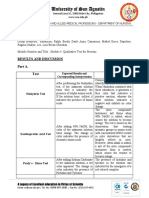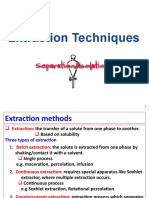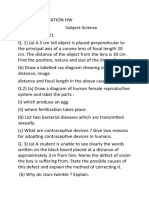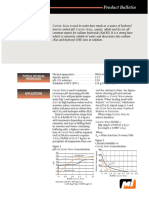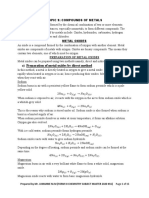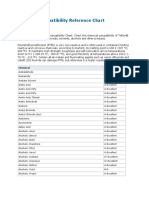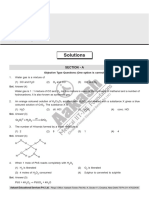Periodicity
Periodicity
Uploaded by
paulcampbell37Copyright:
Available Formats
Periodicity
Periodicity
Uploaded by
paulcampbell37Copyright
Available Formats
Share this document
Did you find this document useful?
Is this content inappropriate?
Copyright:
Available Formats
Periodicity
Periodicity
Uploaded by
paulcampbell37Copyright:
Available Formats
PERIODICITY
Answer all questions
Name:.
Mark for section B /34
Mark for section C /15
Total: . /49
Grade..
1.
(a)
Write equations to show what happens when the following oxides are added to water and
predict approximate values for the pH of the resulting solutions.
(i)
sodium oxide
Equation ...........................................................................................................
pH .....................................................................................................................
(ii)
sulphur dioxide
Equation ...........................................................................................................
pH .....................................................................................................................
(4)
(b)
What is the relationship between bond type in the oxides of the Period 3 elements and the
pH of the solutions which result from addition of the oxides to water?
.....................................................................................................................................
.....................................................................................................................................
(2)
(Total 6 marks)
2.
In the question below, Z is one of the Period 3 elements Na, Mg, Al, Si or P.
The oxide of element Z is a crystalline solid with a very high melting point. This oxide is
classified as an acidic oxide but it is not soluble in water.
(i)
Deduce the type of crystal shown by the oxide of element Z.
............
(ii)
Identify element Z.
............
(iii)
Write an equation for a reaction which illustrates the acidic nature of the oxide
of element Z.
............
(4)
(Total 4 marks)
3.
(a)
The Period 3 elements, Na, Mg, Al, Si, P and S, all form oxides when the elements are
burned in an excess of oxygen.
(i)
Give the formula of an oxide of one of these elements in which the element is not in
its highest oxidation state. Give the oxidation state of the element in this oxide.
Formula of oxide ..............................................................................................
Oxidation state of element ................................................................................
(ii)
Write an equation for the reaction in which phosphorus(V) oxide is formed from
phosphorus and oxygen.
.......................................................................................................................
(3)
(b)
The melting points of some of the oxides formed by Period 3 elements are given in a
random order below.
(i)
Oxide
Tm/C
2852
73
1610
1275
300
Using the letters A to E, give two oxides which have simple molecular structures.
Explain your answer.
Oxide 1 ..............................................................................................................
Oxide 2 ..............................................................................................................
Explanation .......................................................................................................
........................................................................................................................
(ii)
Give a simple chemical test which could be used to show which of the oxides in
the table is sodium oxide. State the observation you would make.
Chemical test .................................................................................................
....................................................................................................................
Observation .......................................................................................................
(6)
(Total 9 marks)
4.
Consider the following oxides.
Na2O, MgO, Al2O3, SiO2, P4O10, SO3
(a)
Identify one of the oxides from the above which
(i)
can form a solution with a pH less than 3 ........................................................
(ii)
can form a solution with a pH greater than 12 .................................................
(2)
(b)
Write an equation for the reaction between
(i)
MgO and HNO3
...........................................................................................................................
(ii)
SiO2 and NaOH
...........................................................................................................................
(iii)
Na2O and H3PO4
...........................................................................................................................
(3)
(c)
Explain, in terms of their type of structure and bonding, why P4O10 can be vaporised by
gentle heat but SiO2 cannot.
.....................................................................................................................................
.....................................................................................................................................
.....................................................................................................................................
.....................................................................................................................................
(4)
(Total 9 marks)
5.
(a)
(i)
Write an equation for the reaction of sodium with cold water.
...........................................................................................................................
(1)
(ii)
By referring to the bonding and structure of silicon, suggest why silicon does not
react with cold water.
...........................................................................................................................
...........................................................................................................................
...........................................................................................................................
(2)
(b)
The oxides of elements of Period 3 react to form salts with aqueous sodium hydroxide or
with aqueous sulphuric acid or with both of these reagents. Give the formula of an oxide
of an element of Period 3 that reacts with:
(i)
aqueous sodium hydroxide only;
Formula of oxide...............................................................................................
(1)
(ii)
aqueous sulphuric acid only;
Formula of oxide...............................................................................................
(1)
(iii)
aqueous sodium hydroxide and aqueous sulphuric acid.
Formula of oxide...............................................................................................
(1)
(Total 6 marks)
6.
(a)
P and Q are oxides of Period 3 elements.
Oxide P is a solid with a high melting point. It does not conduct electricity when solid but
does conduct when molten or when dissolved in water. Oxide P reacts with water forming
a solution with a high pH.
Oxide Q is a colourless gas at room temperature. It dissolves in water to give a solution
with a low pH.
(i)
Identify P. State the type of bonding present in P and explain its electrical
conductivity. Write an equation for the reaction of P with water.
(ii)
Identify Q. State the type of bonding present in Q and explain why it is a gas at
room temperature. Write an equation for the reaction of Q with water.
(9)
(b)
R is a hydroxide of a Period 3 element. It is insoluble in water but dissolves in both
aqueous sodium hydroxide and aqueous sulphuric acid.
(i)
Give the name used to describe this behaviour of the hydroxide.
(ii)
Write equations for the reactions occurring.
(iii)
Suggest why R is insoluble in water.
(6)
(Total 15 marks)
You might also like
- CXC Physics Notes - Section ADocument13 pagesCXC Physics Notes - Section Apaulcampbell37100% (12)
- Laundry SoapDocument16 pagesLaundry SoapLen Surban100% (1)
- Hydroxy and Carbonyl CompoundsDocument11 pagesHydroxy and Carbonyl CompoundsFatima SiddiquiNo ratings yet
- Exampro GCSE Chemistry: C3 Chapter 1 HigherDocument25 pagesExampro GCSE Chemistry: C3 Chapter 1 HigherSamuel Kalembo100% (1)
- Redox, Group 2 and Group 7 TestDocument7 pagesRedox, Group 2 and Group 7 Testpaulcampbell37No ratings yet
- Experiment 6. Heat of Formation of NaClDocument10 pagesExperiment 6. Heat of Formation of NaClAmanda LazoNo ratings yet
- 2.4 2.5 2.6 Assessed HomeworkDocument7 pages2.4 2.5 2.6 Assessed HomeworkRabia Rafique100% (1)
- 3.2.4 Revision QuestionsDocument2 pages3.2.4 Revision QuestionsDANIEL NEWMANNo ratings yet
- Unit 8 Test - FinalDocument10 pagesUnit 8 Test - FinalarsonNo ratings yet
- Periodicity Past QuestionsDocument17 pagesPeriodicity Past QuestionsMohammad KhanNo ratings yet
- Redox Worksheet 2023Document5 pagesRedox Worksheet 2023uzair ahmedNo ratings yet
- Igcse Acids, Bases and Salts PDFDocument10 pagesIgcse Acids, Bases and Salts PDFbilly ogadaNo ratings yet
- 2.04 - 2.06 Redox Reactions, Halogens and Alkali Earth MetalsDocument37 pages2.04 - 2.06 Redox Reactions, Halogens and Alkali Earth Metalsgobod52280No ratings yet
- CHEMJUNE2003C4Document10 pagesCHEMJUNE2003C4api-3726022No ratings yet
- A2 Ch.17 QuestionsDocument14 pagesA2 Ch.17 QuestionsDigola WillsNo ratings yet
- Topic 09.3 Group IVDocument3 pagesTopic 09.3 Group IVzafarchem_iqbalNo ratings yet
- Periodic Table, Group 2 and The Halogens 1 QPDocument13 pagesPeriodic Table, Group 2 and The Halogens 1 QPmalakNo ratings yet
- zq1d53 4T 1Document5 pageszq1d53 4T 1Abhir AppaiahNo ratings yet
- Year 13 Organic Chemistry Test 2Document15 pagesYear 13 Organic Chemistry Test 2kasumbaraymond0756519001No ratings yet
- chemistry revisionDocument13 pageschemistry revisiongopalNo ratings yet
- Chemistry 9Document7 pagesChemistry 9fcvmwm2bzpNo ratings yet
- Quiz - 1 - Matter & StoichiometryDocument4 pagesQuiz - 1 - Matter & StoichiometryDaniel Ngenokesho WandyaNo ratings yet
- t2 Chem Revision Ex 22Document19 pagest2 Chem Revision Ex 22Nicholas OwNo ratings yet
- 2 HoursDocument17 pages2 HoursOTTO OLIMANo ratings yet
- As Level Chemistry: Topic 6 - Redox, Group 2 and Group 7 Assessed HomeworkDocument10 pagesAs Level Chemistry: Topic 6 - Redox, Group 2 and Group 7 Assessed HomeworkSumathi GanasenNo ratings yet
- ChemistryDocument7 pagesChemistrycarolineholter1No ratings yet
- Chemistry Worksheet Acid and Bases - 240217 - 144437Document18 pagesChemistry Worksheet Acid and Bases - 240217 - 144437Birds HomeNo ratings yet
- 10 Homework PackDocument10 pages10 Homework PackatasayNo ratings yet
- Metal p4 Ws 4Document10 pagesMetal p4 Ws 4NonnoonoNo ratings yet
- 4 Carbonate and Sulphur QPDocument13 pages4 Carbonate and Sulphur QPAli AshrafNo ratings yet
- AS - Group 1,2,& 7Document25 pagesAS - Group 1,2,& 7vintu pvNo ratings yet
- Y12 Group 2, 7 and Redox TestDocument10 pagesY12 Group 2, 7 and Redox TestAnela XVIINo ratings yet
- Acids, Bases & Salts 5 QPDocument7 pagesAcids, Bases & Salts 5 QPValerine VictoriaNo ratings yet
- End of Week Chemistry TestDocument4 pagesEnd of Week Chemistry TestOlolade OlaleyeNo ratings yet
- 3 The Periodic Table QPDocument11 pages3 The Periodic Table QPAli AshrafNo ratings yet
- I6 Reactions of Ions in Aqueous SolutionDocument16 pagesI6 Reactions of Ions in Aqueous Solution/ “Nu” /No ratings yet
- Mock Olvl.2Document19 pagesMock Olvl.2SumitNo ratings yet
- t2 Chem Revision Ex 17Document16 pagest2 Chem Revision Ex 17Nicholas OwNo ratings yet
- A-Level Paper 1 pp1Document14 pagesA-Level Paper 1 pp1fibim38794No ratings yet
- My TestDocument4 pagesMy TestMateusz MigdałNo ratings yet
- Cape Chemistry QuestionsDocument58 pagesCape Chemistry QuestionsShanoyaNo ratings yet
- Review Pack 1st Term (23-24)Document21 pagesReview Pack 1st Term (23-24)Teck TieNo ratings yet
- 0620 s21 QP 42Document12 pages0620 s21 QP 42Ali Muhammad KambaNo ratings yet
- AS CH 01 Test Question Database With AnswersDocument40 pagesAS CH 01 Test Question Database With AnswersrrdshnhsNo ratings yet
- Class 10 Mid Exam 2019Document12 pagesClass 10 Mid Exam 2019Khalid HassanNo ratings yet
- 5070 Mock 1 P2 - 2024Document10 pages5070 Mock 1 P2 - 2024ShamsaNo ratings yet
- Acids, Bases & Salts 2 QP PDFDocument11 pagesAcids, Bases & Salts 2 QP PDFLaraib FatimahNo ratings yet
- IGCSE Past Paper Qs-Topic 1 To Topic 15Document89 pagesIGCSE Past Paper Qs-Topic 1 To Topic 15王涛No ratings yet
- 3 Reactivity Series and Metals QPDocument18 pages3 Reactivity Series and Metals QPAli AshrafNo ratings yet
- Topic - 14 - HW 2Document11 pagesTopic - 14 - HW 2max baxNo ratings yet
- Group 7Document11 pagesGroup 7yahvip07No ratings yet
- Periodic Table & Atomic Structure Self Study SheetDocument13 pagesPeriodic Table & Atomic Structure Self Study Sheetykkym9sc6cNo ratings yet
- Mytest 1Document8 pagesMytest 1Aditi ChauhanNo ratings yet
- 4.1.2, 4.1.3 Exam QuestionsDocument9 pages4.1.2, 4.1.3 Exam QuestionsHyder OmarNo ratings yet
- SCLP Samaj School Year 10 Chemistry Revision WorksheetDocument11 pagesSCLP Samaj School Year 10 Chemistry Revision WorksheetHarshil PatelNo ratings yet
- Q1. (A) Samples of Solid Sodium Fluoride, Sodium Chloride, Sodium Bromide and SodiumDocument86 pagesQ1. (A) Samples of Solid Sodium Fluoride, Sodium Chloride, Sodium Bromide and Sodiumli weiNo ratings yet
- Water and HydrogenDocument7 pagesWater and HydrogenOkumu KevinsNo ratings yet
- Redox Group 2 and Group 7 TestDocument9 pagesRedox Group 2 and Group 7 TestSonic EightNo ratings yet
- Chemical Reactions WorksheetDocument10 pagesChemical Reactions Worksheetuvigodage2008No ratings yet
- Isomerism 2 QPDocument9 pagesIsomerism 2 QPPragna AnanthNo ratings yet
- Amount of SubstanceDocument13 pagesAmount of Substanceyahvip07No ratings yet
- PH - Buffers 1 QPDocument12 pagesPH - Buffers 1 QPRoshae SinclairNo ratings yet
- Group 2Document6 pagesGroup 2Muhammad Asim RazaNo ratings yet
- Rates and Equilibrium TestDocument9 pagesRates and Equilibrium Testpaulcampbell37No ratings yet
- Bonding, Structure and Periodicity TestDocument8 pagesBonding, Structure and Periodicity Testpaulcampbell37No ratings yet
- Enthalpy Change Mark SchemeDocument4 pagesEnthalpy Change Mark Schemepaulcampbell37No ratings yet
- Electrode Potentials and Fuel Cells TestDocument7 pagesElectrode Potentials and Fuel Cells Testpaulcampbell37No ratings yet
- Mole Exam Mark SchemeDocument17 pagesMole Exam Mark Schemepaulcampbell37No ratings yet
- Transition Metal ComplexDocument25 pagesTransition Metal Complexpaulcampbell37No ratings yet
- Transition Metals TestDocument12 pagesTransition Metals Testpaulcampbell37No ratings yet
- Rates of RXN Mark SchemeDocument34 pagesRates of RXN Mark Schemepaulcampbell37No ratings yet
- Redox Trends-Qa Mark SchemeDocument29 pagesRedox Trends-Qa Mark Schemepaulcampbell37No ratings yet
- Redox Equilibria Mark SchemeDocument7 pagesRedox Equilibria Mark Schemepaulcampbell37No ratings yet
- Peace and Conflict ResolutionDocument5 pagesPeace and Conflict Resolutionpaulcampbell37No ratings yet
- The Solubility of Aluminum Hydroxide in Acidic and Basic Media at CL,?Document4 pagesThe Solubility of Aluminum Hydroxide in Acidic and Basic Media at CL,?Vasant HiremathNo ratings yet
- Guide Formulations: Skin Care Hair Care New Trends Make UpDocument35 pagesGuide Formulations: Skin Care Hair Care New Trends Make UpMkt BRAMNo ratings yet
- TDS Medmuls MX 3Document3 pagesTDS Medmuls MX 3Drarshad RazaNo ratings yet
- Internship ICL Report - Zeeshan Ul HaqDocument44 pagesInternship ICL Report - Zeeshan Ul HaqfreshynaqviNo ratings yet
- 8 Titration of Acids and BasesDocument5 pages8 Titration of Acids and BasesKetsia MoussyNo ratings yet
- Chem7a BSN-1-J Module4Document5 pagesChem7a BSN-1-J Module4Kiana JezalynNo ratings yet
- Viskositas NaOH AkhirnyaaDocument2 pagesViskositas NaOH AkhirnyaaLisa Ayu Wulandari0% (1)
- Chap-1-2 ExtractionDocument73 pagesChap-1-2 Extractionlishan asefaNo ratings yet
- Enrich Agro Food Product Pvt. LTD Chemical ListDocument6 pagesEnrich Agro Food Product Pvt. LTD Chemical ListYOGENDER NIJHAVANNo ratings yet
- S-Block Notes-1Document26 pagesS-Block Notes-1Kishore SurampalliNo ratings yet
- Ballestra MAZZONIDocument30 pagesBallestra MAZZONICarlo Dalmonte100% (1)
- Chemistry Lab Write Up # 9Document4 pagesChemistry Lab Write Up # 9Rachael BrownNo ratings yet
- Rice and Einkorn Wheat Husks Reinforced Poly (Lactic Acid) (PLA)Document14 pagesRice and Einkorn Wheat Husks Reinforced Poly (Lactic Acid) (PLA)Sharol Nathalia Garzon SerranoNo ratings yet
- Progress in Energy and Combustion ScienceDocument24 pagesProgress in Energy and Combustion ScienceIntenNo ratings yet
- Questions of Summer Holiday HomeworkDocument6 pagesQuestions of Summer Holiday HomeworkVisual lordNo ratings yet
- Lactic Acid TR 2015Document27 pagesLactic Acid TR 2015Huỳnh Thị Thu HiềnNo ratings yet
- 〈670〉 Auxiliary Packaging ComponentsDocument7 pages〈670〉 Auxiliary Packaging Componentsmehrdarou.qaNo ratings yet
- Caustic Soda Plant DesignDocument27 pagesCaustic Soda Plant Designu19met012pNo ratings yet
- Austic ODA: Product BulletinDocument2 pagesAustic ODA: Product BulletinHunterNo ratings yet
- Monomethylation of Amphetamines - (WWW - Rhodium.ws)Document4 pagesMonomethylation of Amphetamines - (WWW - Rhodium.ws)Adam BruhNo ratings yet
- Chemistry STD - IXDocument17 pagesChemistry STD - IXPrem GomesNo ratings yet
- Aluminium NitrateDocument3 pagesAluminium NitrateAbinov Kumar KTNo ratings yet
- Compounds of MetalsDocument15 pagesCompounds of MetalsMycovich Myco100% (1)
- Chemical Compatibility Reference Chart: Teflon® PTFEDocument17 pagesChemical Compatibility Reference Chart: Teflon® PTFEWbeimar Zuluaga ZuluagaNo ratings yet
- Problem Set III Stoichiometry: Molar Mass and Numbers of AtomsDocument4 pagesProblem Set III Stoichiometry: Molar Mass and Numbers of AtomsKarel Sanchez HernandezNo ratings yet
- PhenolsDocument11 pagesPhenolsSai Sasivardhan GampaNo ratings yet
- ASTM D512 - Standard Test Methods For Chloride Ion in WaterDocument7 pagesASTM D512 - Standard Test Methods For Chloride Ion in Water23h45100% (1)
- Hydrogen 11th Chemistry MCQDocument18 pagesHydrogen 11th Chemistry MCQsameer devidasNo ratings yet










